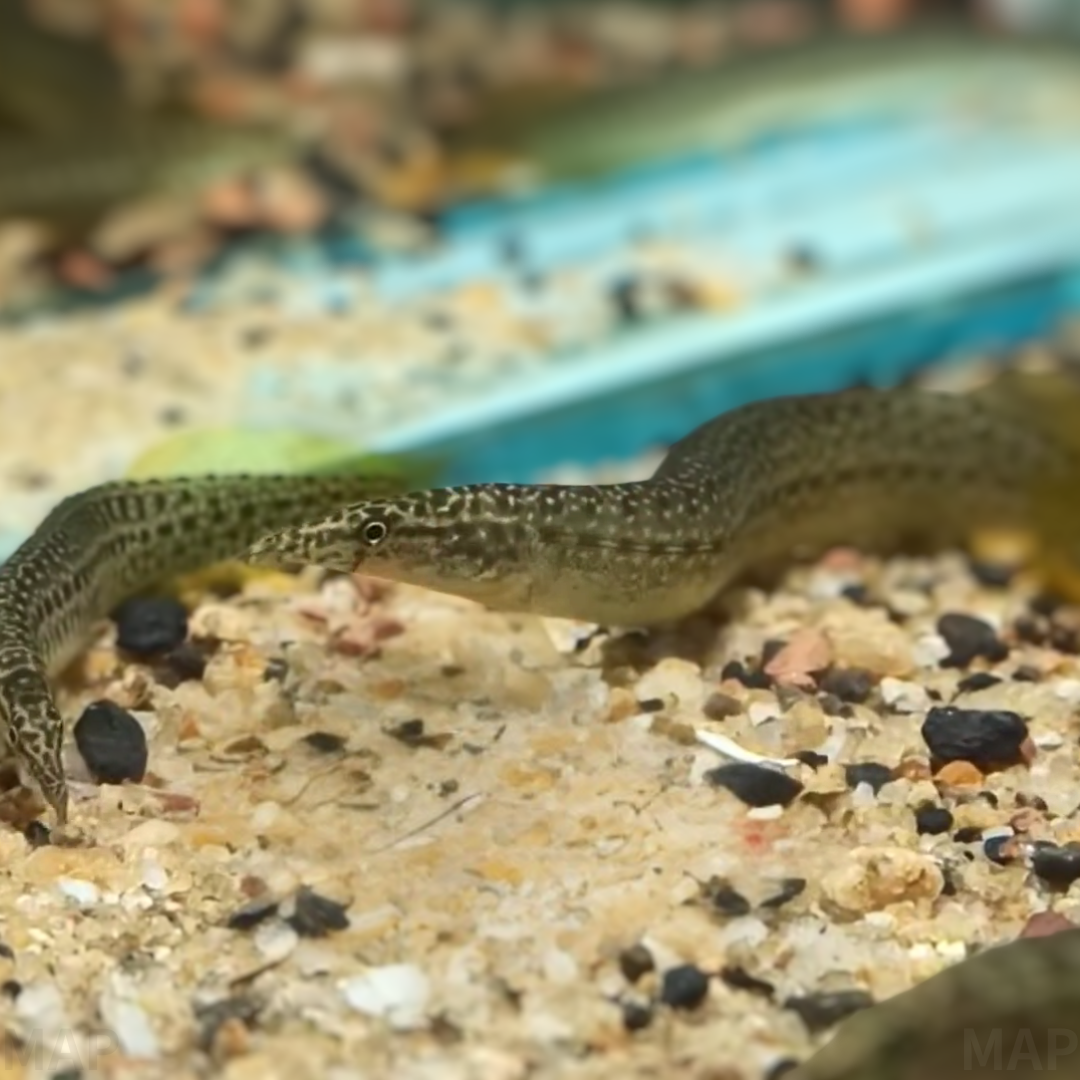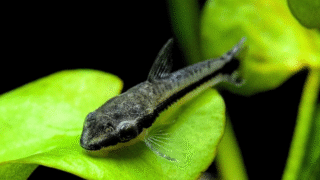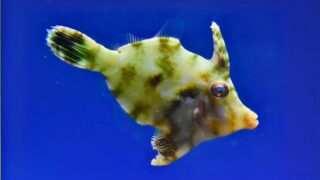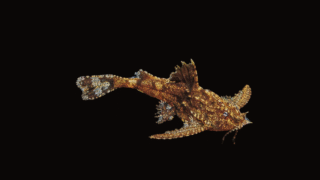AI音声解説※一部単語の読み間違いがございます。ご了承ください。
解説 / Description
グリーンスパイニールは、ヘビやウナギを思わせるしなやかな体と、好奇心旺盛な大きな瞳が特徴的な、南アジア原産の底棲魚です。そのユニークな外見とは裏腹に、性格は臆病ながらも非常に人懐っこく、飼育環境に慣れると飼い主の手から直接餌を食べるようにもなります。丈夫で飼育しやすいため、少し変わった魚を飼育してみたいと考えるアクアリストにとって、入門種としても最適な存在です。砂に潜る習性や、愛嬌のある仕草は、多くの愛好家を魅了し続けています。 The Green Spiny Eel is a bottom-dwelling fish from South Asia, characterized by its slender, snake-like body and large, curious eyes. Despite its unique appearance, it has a shy yet very personable temperament, often learning to take food directly from the owner’s hand once acclimated. It is hardy and easy to care for, making it an ideal choice for aquarists looking to keep a more “oddball” fish. Its habit of burrowing in the sand and charming behaviors continue to captivate many enthusiasts.
基本情報 / Basic Information
| 学名 / Scientific Name | Macrognathus pancalus |
|---|---|
| 通称 / Common Name | インドグリーンスパイニール, イエロースパイニールIndian Green Spiny Eel, Yellow Spiny Eel, Barred Spiny Eel |
| 分類 / Family | タウナギ目 トゲウナギ科Synbranchiformes, Mastacembelidae |
| 英名 / English Name | Barred Spiny Eel |
| 分布 / Distribution | インド、パキスタン、バングラデシュ、ネパール、スリランカIndia, Pakistan, Bangladesh, Nepal, Sri Lanka |
| 最大体長 / Max Size | 約15cm – 18cmApprox. 15cm – 18cm (6-7 inches) |
| 寿命 / Lifespan | 5年以上。一部で2〜3年という情報もありますが、適切な飼育環境下ではより長く生きると考えられています。5+ years. Some sources suggest 2-3 years, but this is likely an underestimate in proper aquarium conditions. |
飼育環境 / Aquarium Environment
| 水槽サイズ / Tank Size | 単独飼育であれば45cm規格水槽(約40L)から可能です。複数飼育や混泳の場合は、60cm規格水槽(約60L)以上を推奨します。A 45cm tank (approx. 40L) is possible for a single specimen. For multiple eels or community tanks, a 60cm tank (approx. 60L) or larger is recommended. |
|---|---|
| 水温 / Temperature | 20 – 28°C (白点病の予防のため、26°C以上を維持するのが望ましいです) |
| 水質 / Water Quality | 弱酸性 〜 中性 (pH 6.0 – 7.5)。水質への適応力は比較的高いです。Slightly acidic to neutral (pH 6.0 – 7.5). They are relatively adaptable to water parameters. |
| レイアウト / Layout | 彼らが潜るための、粒が細かく角のない砂(ボトムサンド、田砂など)を最低5cm以上の厚さで敷くことが「必須」です。流木や土管などの隠れ家も必ず設置してください。水草は、掘り返されないようアヌビアスやミクロソリウムなどの活着性が適しています。A substrate of fine, smooth sand (at least 5cm deep) is “mandatory” for burrowing. Hiding places like driftwood or caves are also essential. Rooted plants may be uprooted, so attached plants like Anubias or Microsorum are suitable. |
| 注意点 / Precautions | 「脱走の名人」です。水槽の蓋は必須であり、フィルターのパイプ周りやコードの隙間など、考えられる全ての隙間をウールマットやスポンジで完璧に塞いでください。大磯砂など角のある底床材は皮膚を傷つけ、病気の原因となるため絶対に使用しないでください。They are “escape artists.” A tight-fitting lid is mandatory. All gaps, including those for filter pipes and cords, must be completely sealed. Never use sharp gravel, as it will damage their delicate skin and cause infections. |
餌と給餌 / Feeding
| 餌の種類 / Diet | 肉食性で、冷凍アカムシやイトメなどの生餌・冷凍餌を強く好みます。沈下性の肉食魚用タブレットなども食べますが、個体差が大きく、人工飼料には生涯慣れない場合もあります。Carnivorous. They strongly prefer live or frozen foods like bloodworms and tubifex worms. Sinking carnivorous pellets may be accepted, but some individuals may never adapt to artificial foods. |
|---|---|
| 給餌のポイント / Feeding Tips | 泳ぎの素早い混泳魚に餌を奪われがちです。痩せさせないよう、ピンセットで直接口元へ運ぶ「ターゲットフィーディング」が非常に有効です。環境に慣れると、飼い主を覚えて水槽前面で餌をねだるようになります。They are often outcompeted for food by faster tank mates. “Target feeding” with tweezers is highly effective to ensure they eat enough. Once settled, they will learn to recognize their owner and beg for food. |
性格と混泳 / Temperament and Tank Mates
| 性格 / Temperament | 基本的には非常に温和ですが、臆病な一面も持ちます。安全な環境だと認識すると、人懐っこいペットフィッシュとしての一面を見せるようになります。Generally very peaceful, but can be shy. Once they feel secure in their environment, they reveal a personable, pet-like side. |
|---|---|
| 混泳の相性 / Compatibility | 口に入るサイズの小型魚(ネオンテトラなど)や小型のエビは捕食対象となるため混泳できません。ラスボラやグラミーなど、遊泳域が重ならない温和な中〜上層魚が適しています。同種同士の混泳は、十分なスペースと隠れ家があれば可能です。Small fish (like Neon Tetras) and dwarf shrimp that fit in their mouth will be eaten. Peaceful, mid-to-top dwelling fish like Rasboras or Gouramis are suitable tank mates. Keeping multiple spiny eels is possible with sufficient space and hiding spots. |
病気と対策 / Diseases and Prevention
| かかりやすい病気 / Common Diseases | 1. 不適切な底床材による皮膚の擦り傷と、そこからの二次的な細菌感染症や水カビ病。 2. 低水温時に発生しやすい白点病。 3. 底床の汚れが原因となるエロモナス症などの細菌性疾患。1. Skin abrasions from improper substrate, leading to secondary fungal or bacterial infections. 2. Ich (White Spot Disease), especially in low temperatures. 3. Bacterial diseases like Aeromonas, often linked to dirty substrate. |
|---|---|
| 対策と予防 / Prevention | 最良の予防は、飼育環境を整えることです。角のない滑らかな砂を使用すること。水温を26°C以上に安定させること。そして、週に一度はプロホースなどで砂の中の汚れをしっかり吸い出し、底床を清潔に保つことが最も重要です。The best prevention is proper husbandry. Use smooth, fine sand. Maintain a stable temperature (ideally 26°C or higher). Most importantly, keep the substrate clean by vacuuming it weekly with a siphon. |
増やし方(繁殖) / Breeding
| 繁殖形態 / Reproduction | 水面に浮かべた浮草(ホテイアオイなど)の根に、粘着性のある卵を産み付けます。They are egg-scatterers, laying adhesive eggs among the roots of floating plants (like Water Hyacinth). |
|---|---|
| 繁殖のポイント / Breeding Tips | 水槽内での繁殖は非常に難易度が高いです。雨季を模倣した環境(浮草、水質の変化)が引き金になると言われています。最大の難関は孵化後にあり、稚魚は非常に強い共食いの性質を持ちます。生存率を上げるには、稚魚の密度を下げ、隠れ家を大量に用意し、動物プランクトンなどの餌を絶対に切らさない管理が必要です。Breeding in aquariums is very difficult. It is reportedly triggered by simulating the rainy season (floating plants, water changes). The greatest challenge is post-hatch; the fry are extremely cannibalistic. To raise them, density must be low, abundant hiding places provided, and a constant supply of food (like infusoria) must be available. |
雑学と豆知識 / Trivia and Fun Facts
| 雑学・豆知識 / Trivia & Fun Facts | ・名前は「イール(ウナギ)」ですが、分類学的にはウナギ(ウナギ目)とは全く異なり、「トゲウナギ(タウナギ目)」の仲間です。背鰭の前方にある独立した短い棘(トゲ)が、スパイニー(棘のある)イールと呼ばれる由来です。 ・学名は$Macrognathus pancalus$ですが、過去には近縁の$Mastacembelus$属に分類されていたこともあります。 ・原産地のインドなどでは、観賞魚としてだけでなく重要な食用魚としても扱われ、市場で高値で取引されることがあります。 ・日本へは安定して輸入されており、比較的手頃な価格で入手できるため、「エントリーレベルの風変わりな魚」として、多くの愛好家に親しまれています。・Although named “eel,” they are not true eels (Anguilliformes). They belong to the “Spiny Eel” order (Synbranchiformes). Their name comes from the small, isolated spines located in front of their dorsal fin. ・The scientific name is $Macrognathus pancalus$, though it was historically classified in the related genus $Mastacembelus$. ・In their native regions like India, they are valued not only as ornamental fish but also as an important food source, fetching high prices at market. ・They are regularly imported to Japan and available at reasonable prices, making them a popular “entry-level oddball fish” for many hobbyists. |
|---|
まとめ / Conclusion
グリーンスパイニールは、その特異な外見と、飼育者に慣れると見せる人懐っこい性格とのギャップが非常に魅力的な魚です。彼らとの暮らしを長く楽しむための鍵は、非常にシンプルです。 The Green Spiny Eel is a fascinating fish, defined by the delightful contrast between its unusual appearance and its personable, pet-like behavior once it settles in. The key to a long and happy life with them is simple.
それは、彼らの本能を満たす「潜るための角のない滑らかな砂」を用意すること、そして彼らの能力を侮らない「完璧な脱走防止策」を施すこと。この2点さえ確実に守れば、彼らは非常に丈夫で飼育しやすく、あなたの水槽で愛嬌を振りまく、かけがえのないパートナーとなってくれることでしょう。 Provide them with the “smooth, fine sand” their instincts demand for burrowing, and implement “flawless escape prevention” that respects their abilities. If you honor these two essential needs, you will find them to be incredibly hardy, easy to care for, and an irreplaceable, charming partner in your aquarium.
▶ 記事の生体をAMAZONで買う ▶ 記事の生体をYahooで買う











コメント